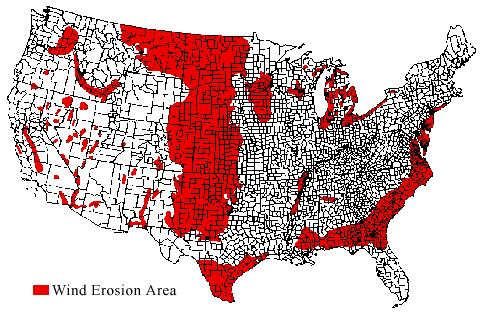

Wind erosion is a serious threat to food security and contributes to the degradation
of a sustainable agriculture in the United States and throughout the world. In addition, dust storms affect air
quality and airborne dust has significant economic, health, ecological, and hydrological impacts.
Soil erosion by wind is worse in
arid and semiarid regions. Areas most susceptible to wind erosion on
agricultural land include much of North Africa and the Near East; parts of
southern, central, and eastern Asia; the Siberian Plains; Australia; northwest
China; southern South America; and North America.
During the 1930's, a prolonged drought culminated in dust storms and soil destruction of disastrous proportions. The "black blizzards" of the resulting Dust Bowl inflicted great hardships on the people and the land.
Over seventy years after the Dust Bowl ended, wind erosion continues to threaten the sustainability of our nations' natural resources. As recently as the spring of 1996, wind erosion severely damaged agricultural land throughout the Great Plains. On cropland, about 70 million hectares (171.8 million acres) are eroded by wind and water at rates that exceed twice the tolerance level for sustainable production (USDA, 1989). On average, wind erosion is responsible for about 40 percent of this loss (Hagen, 1994), and can increase markedly in drought years (Hagen and Woodruff, 1973). In the United States, wind erosion is the dominant problem on about 30 million hectares (73.6 million acres) and moderately to severely damages approximately 2 million hectares (4.9 million acres) annually (USDA, 1965). According to the 1992 National Resources Inventory (NRI), the estimated annual soil loss from wind erosion on nonfederal rural land in the United States was 2.5 tons per acre per year (SCS-USDA, 1994). This number is a decrease from 3.3 tons per acre per year in the 1982 NRI. However much of this reduction was a result of enrollment of land classified as highly erodible in the Conservation Reserve Program (CRP). The CRP enrollment for much of this acreage is scheduled to retire within the next few years.
Wind erosion physically removes the lighter, less dense soil constituents such as organic matter, clays, and silts. Thus it removes the most fertile part of the soil and lowers soil productivity (Lyles, 1975). Lyles (1975) estimated that top soil loss from wind erosion causes annual yield reductions of 339,000 bushels of wheat and 543,000 bushels of grain sorghum on 0.5 million hectares (1.2 million acres) of sandy soils in southwestern Kansas. This loss in productivity has been masked or compensated for over the years by improved crop varieties and increased fertilization. Thus wind erosion reduces potential soil productivity and increases economic costs. Blowing soil impacting plants can also reduce seedling survival and growth, depress crop yields, lower the marketability of vegetable crops, increase the susceptibility of plants to certain types of stress, including diseases, and contribute to transmission to some plant pathogens (Armbrust, 1982 and 1984; Claflin, et al., 1973; Michels et al., 1995). In the long run, the cost of wind erosion control practices can offset the cost of replanting a blown out crop. Some soil from damaged land enters suspension and becomes part of the atmospheric dust load. Dust obscures visibility and pollutes the air, it fills road ditches where it can impact water quality, it causes automobile accidents, fouls machinery, and imperils animal and human health (Skidmore, 1988). In Seward County Kansas alone the state highway department spent over $15,000 in 1996 to remove 965 tons of sand from 500 feet of highway and ditch (Tri-County Area Proposal for EQIP, unpublished report). Wind erosion is a threat to the sustainability of the land as well as the viability and quality of life for rural as well as urban communities.
Wind erosion in the United States is most widespread on agricultural land in
the Great Plains states. Wind erosion is also a serious problem on cultivated
organic soils, sandy coastal areas, alluvial soils along river bottoms, and
other areas in the United States. In addition it is a major cause of soil
degradation in arid and semiarid areas around the world.
Literature Cited
Armbrust, D.V. 1982. Physiological responses to wind and sandblast damage by grain sorghum plants. Agron. Journ. 74:133-135.
Armbrust, D.V. 1984. Wind and sandblast injury to field crops: Effects of plant age. Agron. Journ. 76:991-993.
Claflin, L.E., D.L. Stuteville, and D.V. Armbrust. 1973. Windblown soil in the epidemiology of bacterial leaf spot of alfalfa and common blight of beans. Phytopathology 63:1417-1419.
Hagen, L.J. 1994. Wind erosion in the United States. Proc. of Wind Erosion Symposium, Poznan, Poland. CCLX:25-32.
Hagen, L.J. and N.P. Woodruff. 1973. Air pollution from dust storms in the Great Plains. Atmos. Environ. 7:323-332.
Lyles, L. 1975. Possible effects of wind erosion on soil productivity. Journ. Soil and Water Cons. 30:279-283.
Michels, K., D.V. Armbrust, B.E. Allison, and M.V.K. Sivakumar. 1995. Agron. Journ. 87:620-626.
SCS-USDA. 1994. Summary Report. National Resources Inventory. Washington, D.C. 54 pp.
Skidmore, E.L. 1988. Wind Erosion. In R. Lal (ed.) Soil Erosion Research Methods, 2nd ed., Soil and Water Conserv. Soc., Ankeny, IA. pp.265-293.
U.S. Department of Agriculture. 1965. Soil and water conservation needs - a national inventory. Misc. Publ. 971. U.S. Department of Agriculture, Washington D.C.
U.S. Department of Agriculture. 1989. The second RCA appraisal: soil, water, and related resources on nonfederal land in the United States. Washington, D.C. U.S. Government Printing Office.
Last modified: 09/02/2012